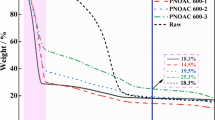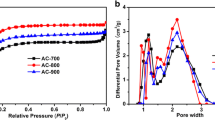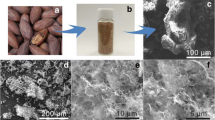Abstract
Activated carbon (AC) derived from biomass lightweight cork (Quercus suber) material was synthesized by KOH activation with different mass ratios of Q. suber: KOH in order to investigate the electrochemical properties of the AC in relation to KOH concentration. A well-defined porous activated carbon was obtained with a high surface area of 1081 m2 g−1 and a high pore volume of 0.66 cm3 g−1 when the Q. suber: KOH mass ratio was fixed at 1:2. A specific capacitance of 166 F g−1 was obtained for the symmetric device at 0.5 A g−1 in 1 M Na2SO4 with energy and power densities of 18.6 and 449.4 W Kg−1, respectively. The device displays good cycling stability after floating test for 200 h at 1.8 V and also displays 99.8% capacitance retention after cycling for 5000 cycles. The excellent electrochemical performance of the device makes it a potential material for supercapacitor application.











Similar content being viewed by others
References
Bello A, Manyala N, Barzegar F et al (2016) Renewable pine cone biomass derived carbon materials for supercapacitor application. RSC Adv 6:1800–1809. doi:10.1039/C5RA21708C
Yu G, Hu L, Vosgueritchian M et al (2011) Solution-processed graphene/MnO2 nanostructured textiles for high-performance electrochemical capacitors. Nano Lett 11:2905–2911. doi:10.1021/nl2013828
Biswal M, Banerjee A, Deo M, Ogale S (2013) From dead leaves to high energy density supercapacitors. Energy Environ Sci 6:1249. doi:10.1039/c3ee22325f
Shaikjee A, Coville NJ (2012) The role of the hydrocarbon source on the growth of carbon materials. Carbon NY 50:3376–3398. doi:10.1016/j.carbon.2012.03.024
Gan JK, Lim YS, Pandikumar A et al (2015) Graphene/polypyrrole-coated carbon nanofiber core–shell architecture electrode for electrochemical capacitors. RSC Adv 5:12692–12699. doi:10.1039/C4RA14922J
Majeau-Bettez G, Hawkins TR, Strømman AH (2011) Life cycle environmental assessment of lithium-ion and nickel metal hydride batteries for plug-in hybrid and battery electric vehicles. Environ Sci Technol 45:4548–4554. doi:10.1021/es103607c
Zhang LL, Zhao XS (2009) Carbon-based materials as supercapacitor electrodes. Chem Soc Rev 38:2520. doi:10.1039/b813846j
Stoller MD, Ruoff RS (2010) Best practice methods for determining an electrode material’s performance for ultracapacitors. Energy Environ Sci 3:1294. doi:10.1039/c0ee00074d
Patil DS, Shaikh JS, Dalavi DS et al (2011) Chemical synthesis of highly stable PVA/PANI films for supercapacitor application. Mater Chem Phys 128:449–455. doi:10.1016/j.matchemphys.2011.03.029
Miller JR, Simon P (2008) Materials science. Electrochemical capacitors for energy management. Science 321:651–652. doi:10.1126/science.1158736
Jain A, Balasubramanian R, Srinivasan MP (2016) Hydrothermal conversion of biomass waste to activated carbon with high porosity: a review. Chem Eng J 283:789–805. doi:10.1016/j.cej.2015.08.014
Chen H, Hu L, Chen M et al (2014) Nickel–cobalt layered double hydroxide nanosheets for high-performance supercapacitor electrode materials. Adv Funct Mater 24:934–942. doi:10.1002/adfm.201301747
Chae JH, Chen GZ (2012) 1.9 V aqueous carbon–carbon supercapacitors with unequal electrode capacitances. Electrochim Acta 86:248–254. doi:10.1016/j.electacta.2012.07.033
Peng C, Zhang S, Zhou X, Chen GZ (2010) Unequalisation of electrode capacitances for enhanced energy capacity in asymmetrical supercapacitors. Energy Environ Sci 3:1499. doi:10.1039/c0ee00228c
Demarconnay L, Raymundo-Piñero E, Béguin F (2010) A symmetric carbon/carbon supercapacitor operating at 1.6 V by using a neutral aqueous solution. Electrochem Commun. doi:10.1016/j.elecom.2010.06.036
An K, Kim W, Park Y, Moon J (2001) Electrochemical properties of high-power supercapacitors using single-walled carbon nanotube electrodes. Adv Funct Mater 11:387–392
Wang H, Liang Y, Mirfakhrai T et al (2011) Advanced asymmetrical supercapacitors based on graphene hybrid materials. Nano Res 4:729–736
Fan Z, Yan J, Wei T et al (2011) Asymmetric supercapacitors based on graphene/MnO2 and activated carbon nanofiber electrodes with high power and energy density. Adv Funct Mater 21:2366–2375. doi:10.1002/adfm.201100058
Sevilla M, Fuertes AB (2016) A green approach to high-performance supercapacitor electrodes: the chemical activation of hydrochar with potassium bicarbonate. Chemsuschem 9:1880–1888. doi:10.1002/cssc.201600426
Wei L, Yushin G (2012) Nanostructured activated carbons from natural precursors for electrical double layer capacitors. Nano Energy 1:552–565. doi:10.1016/j.nanoen.2012.05.002
Wang H, Xu Z, Kohandehghan A et al (2013) Interconnected carbon nanosheets derived from hemp for ultrafast supercapacitors with high energy. ACS Nano 7:5131–5141. doi:10.1021/nn400731g
Wang J, Kaskel S (2012) KOH activation of carbon-based materials for energy storage. J Mater Chem 22:23710. doi:10.1039/c2jm34066f
Lv Y, Zhang F, Dou Y et al (2012) A comprehensive study on KOH activation of ordered mesoporous carbons and their supercapacitor application. J Mater Chem 22:93. doi:10.1039/c1jm12742j
Béguin F, Presser V, Balducci A, Frackowiak E (2014) Carbons and electrolytes for advanced supercapacitors. Adv Mater 26:2219–2251. doi:10.1002/adma.201304137
Bello A, Barzegar F, Madito MJ et al (2016) Stability studies of polypyrole- derived carbon based symmetric supercapacitor via potentiostatic floating test. Electrochim Acta 213:107–114. doi:10.1016/j.electacta.2016.06.151
Li X, Xing W, Zhuo S et al (2011) Preparation of capacitor’s electrode from sunflower seed shell. Bioresour Technol 102:1118–1123. doi:10.1016/j.biortech.2010.08.110
Jain A, Xu C, Jayaraman S et al (2015) Mesoporous activated carbons with enhanced porosity by optimal hydrothermal pre-treatment of biomass for supercapacitor applications. Microporous Mesoporous Mater 218:55–61. doi:10.1016/j.micromeso.2015.06.041
Sulaiman KS, Mat A, Arof AK (2016) Activated carbon from coconut leaves for electrical double-layer capacitor. Ionics 22:911–918. doi:10.1007/s11581-015-1594-9
Xu J, Gao Q, Zhang Y et al (2014) Preparing two-dimensional microporous carbon from Pistachio nutshell with high areal capacitance as supercapacitor materials. Sci Rep 4:845–854. doi:10.1038/srep05545
Barzegar F, Bello A, Fashedemi OO et al (2015) Synthesis of 3D porous carbon based on cheap polymers and graphene foam for high-performance electrochemical capacitors. Electrochim Acta 180:442–450. doi:10.1016/j.electacta.2015.08.148
Laheäär A, Przygocki P, Abbas Q, Béguin F (2015) Appropriate methods for evaluating the efficiency and capacitive behavior of different types of supercapacitors. Electrochem Commun. doi:10.1016/j.elecom.2015.07.022
Zheng X, Lv W, Tao Y et al (2014) Oriented and interlinked porous carbon nanosheets with an extraordinary capacitive performance. Chem Mater 26:6896–6903. doi:10.1021/cm503845q
Lee JW, Hall AS, Kim J-D, Mallouk TE (2012) A facile and template-free hydrothermal synthesis of Mn3O4 nanorods on graphene sheets for supercapacitor electrodes with long cycle stability. Chem Mater 24:1158–1164. doi:10.1021/cm203697w
Manyala N, Bello A, Barzegar F et al (2015) Coniferous pine biomass: a novel insight into sustainable carbon materials for supercapacitors electrode. Mater Chem Phys 182:139–147. doi:10.1016/j.matchemphys.2016.07.015
Wang Y, Alsmeyer DC, McCreery RL (1990) Raman spectroscopy of carbon materials: structural basis of observed spectra. Chem Mater 2:557–563. doi:10.1021/cm00011a018
Malard LM, Pimenta MA, Dresselhaus G, Dresselhaus MS (2009) Raman spectroscopy in graphene. Phys Rep 473:51–87. doi:10.1016/j.physrep.2009.02.003
Sadezky A, Muckenhuber H, Grothe H et al (2005) Raman microspectroscopy of soot and related carbonaceous materials: spectral analysis and structural information. Carbon NY 43:1731–1742. doi:10.1016/j.carbon.2005.02.018
Jawhari T, Roid A, Casado J (1995) Raman spectroscopic characterization of some commercially available carbon black materials. Carbon NY 33:1561–1565. doi:10.1016/0008-6223(95)00117-V
Sze S (2001) Raman spectroscopic characterization of carbonaceous aerosols. Atmos Environ 35:561–568. doi:10.1016/S1352-2310(00)00325-3
Dippel B, Jander H, Heintzenberg J (1999) NIR FT Raman spectroscopic study of flame soot. Phys Chem Chem Phys 1:4707–4712. doi:10.1039/a904529e
Jang Y, Jo J, Choi Y-M et al (2013) Activated carbon nanocomposite electrodes for high performance supercapacitors. Electrochim Acta 102:240–245. doi:10.1016/j.electacta.2013.04.020
Momodu DY, Madito MJ, Barzegar F et al (2017) Activated carbon derived from tree bark biomass for high performance electrochemical capacitors. J Solid State Electrochem 21:859–872. doi:10.1007/s10008-016-3432-z
Taer E, Deraman M, Talib IA et al (2011) Preparation of a highly porous binderless activated carbon monolith from rubber wood sawdust by a multi-step activation process for application in supercapacitors. Int J Electrochem Sci 6:3301–3315
Barzegar F, Bello A, Momodu D et al (2016) Preparation and characterization of porous carbon from expanded graphite for high energy density supercapacitor in aqueous electrolyte. J Power Sources 309:245–253. doi:10.1016/j.jpowsour.2016.01.097
Luo J, Jang HD, Huang J (2013) Effect of sheet morphology on the scalability of graphene-based ultracapacitors. ACS Nano 7:1464–1471. doi:10.1021/nn3052378
Taberna PL, Simon P, Fauvarque JF (2003) Electrochemical characteristics and impedance spectroscopy studies of carbon–carbon supercapacitors. J Electrochem Soc 150:A292. doi:10.1149/1.1543948
Acknowledgements
This work is based on research supported by the South African Research Chairs Initiative (SARChI) of the Department of Science and Technology and the National Research Foundation (NRF) of South Africa (Grant No. 61056). Any opinion, finding and conclusion or recommendation expressed in this material is that of the author(s) and the NRF does not accept any liability in this regard. Faith O. Ochai-Ejeh acknowledges NRF through SARChI in Carbon Technology and Materials, and the Department of Physics at the University of Pretoria for financial support.
Author information
Authors and Affiliations
Corresponding author
Ethics declarations
Conflict of interest
The authors declare no competing financial interest.
Rights and permissions
About this article
Cite this article
Ochai-Ejeh, F.O., Bello, A., Dangbegnon, J. et al. High electrochemical performance of hierarchical porous activated carbon derived from lightweight cork (Quercus suber). J Mater Sci 52, 10600–10613 (2017). https://doi.org/10.1007/s10853-017-1205-4
Received:
Accepted:
Published:
Issue Date:
DOI: https://doi.org/10.1007/s10853-017-1205-4




